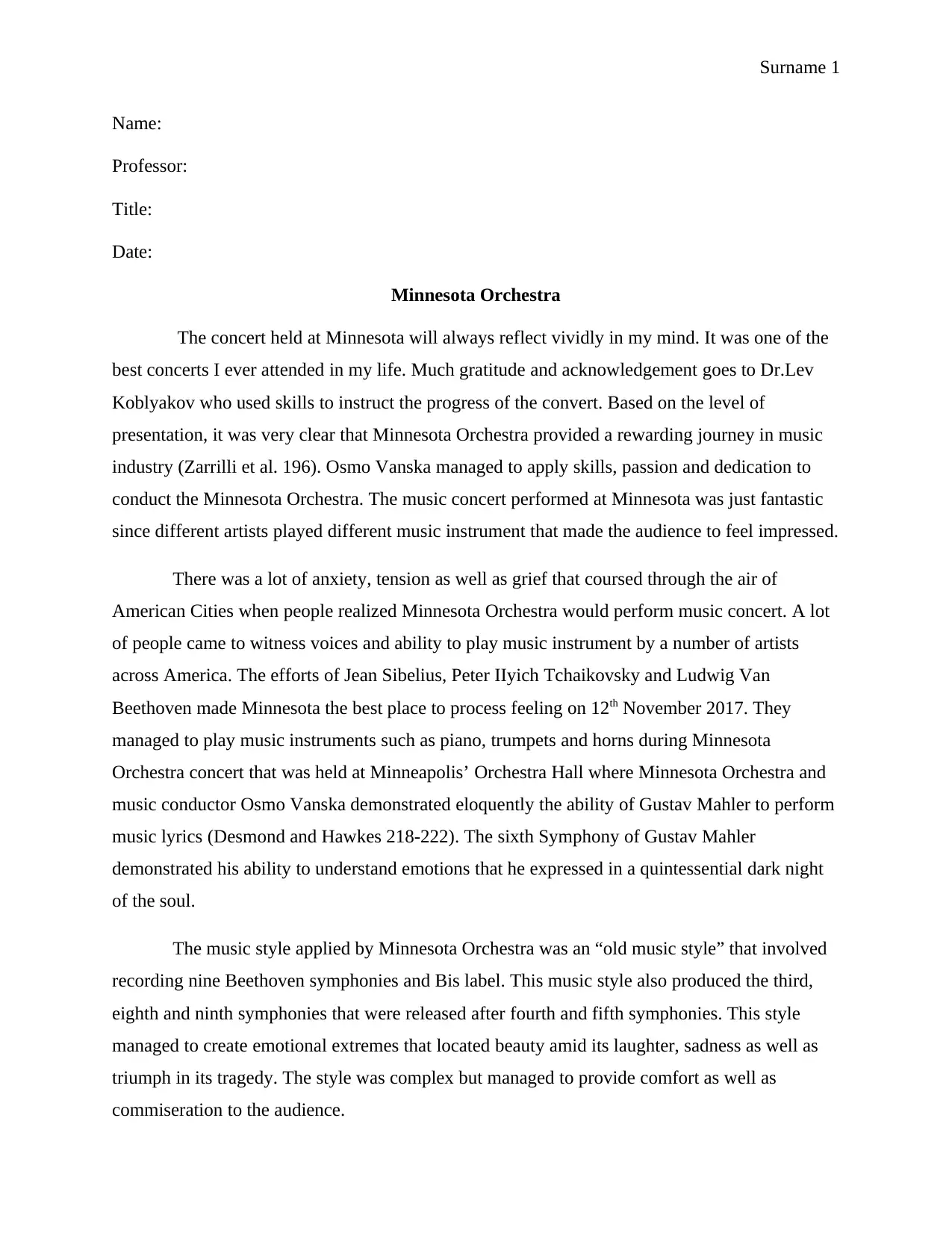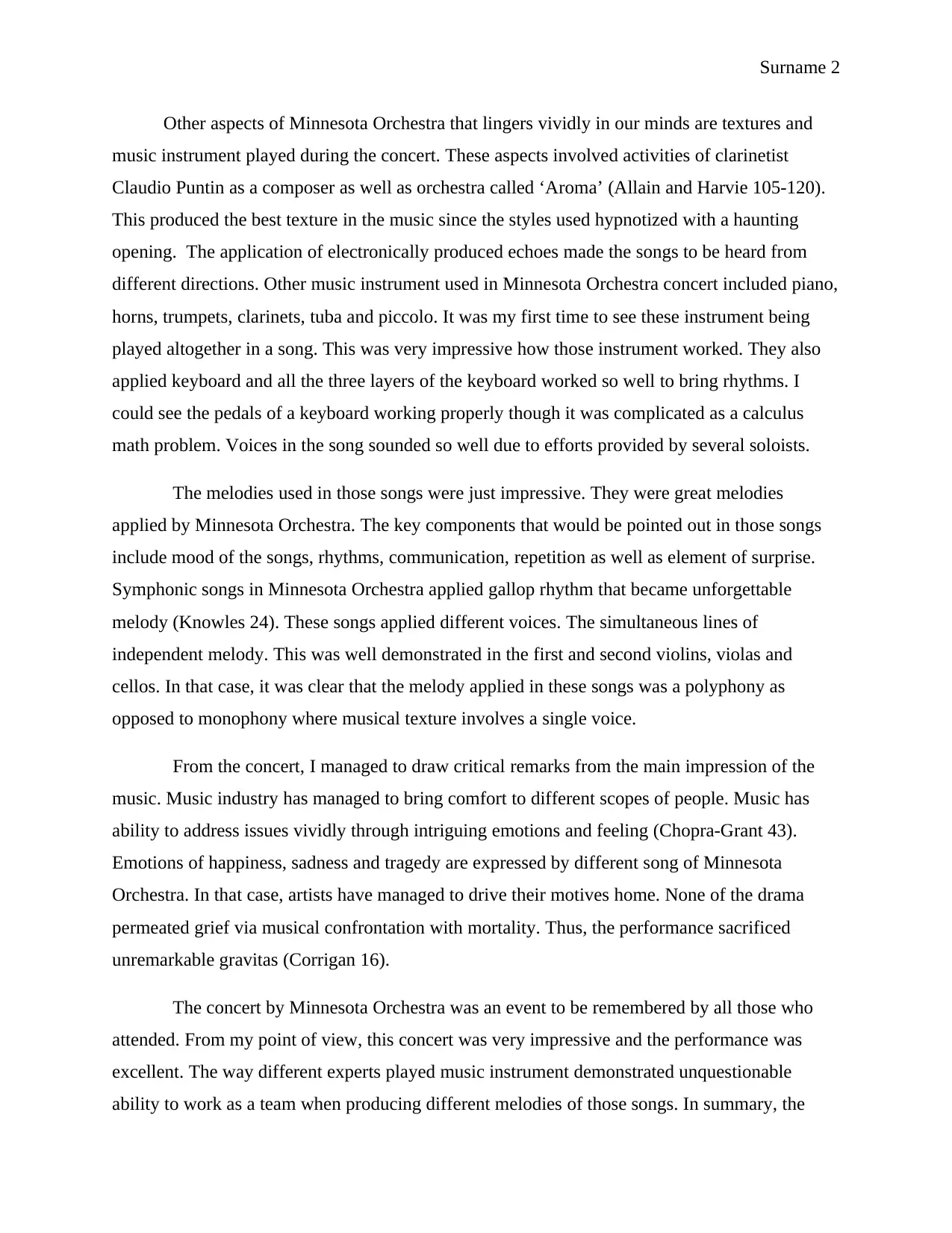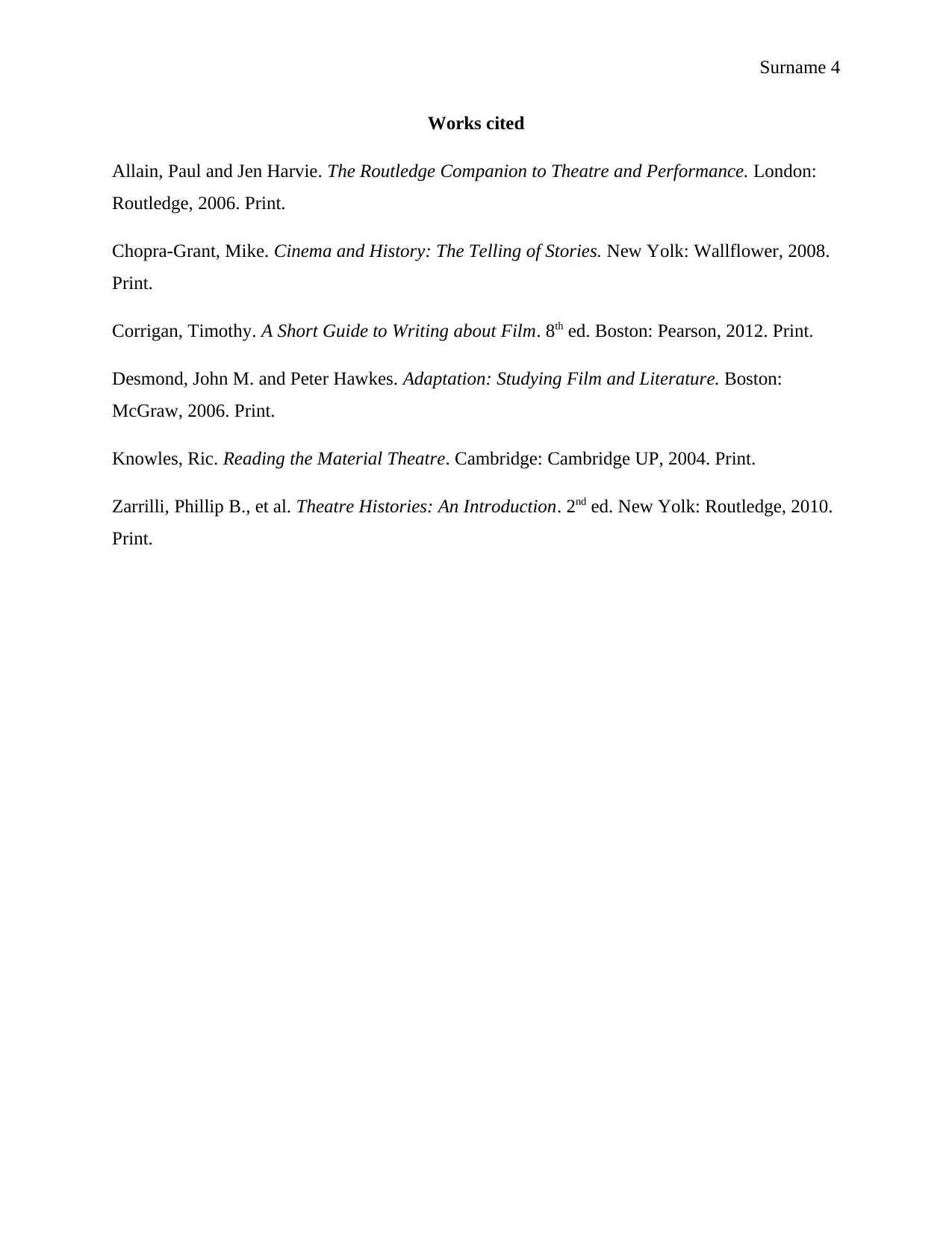Minnesota Orchestra: A Memorable Concert Experience
VerifiedAdded on 2023/06/15
|4
|1032
|300
AI Summary
This article describes the unforgettable concert experience of Minnesota Orchestra, including the music style, textures, and instruments played. It also explores how the artists' emotions were expressed through music and how the concert left a lasting impression on the audience.
Contribute Materials
Your contribution can guide someone’s learning journey. Share your
documents today.

Surname 1
Name:
Professor:
Title:
Date:
Minnesota Orchestra
The concert held at Minnesota will always reflect vividly in my mind. It was one of the
best concerts I ever attended in my life. Much gratitude and acknowledgement goes to Dr.Lev
Koblyakov who used skills to instruct the progress of the convert. Based on the level of
presentation, it was very clear that Minnesota Orchestra provided a rewarding journey in music
industry (Zarrilli et al. 196). Osmo Vanska managed to apply skills, passion and dedication to
conduct the Minnesota Orchestra. The music concert performed at Minnesota was just fantastic
since different artists played different music instrument that made the audience to feel impressed.
There was a lot of anxiety, tension as well as grief that coursed through the air of
American Cities when people realized Minnesota Orchestra would perform music concert. A lot
of people came to witness voices and ability to play music instrument by a number of artists
across America. The efforts of Jean Sibelius, Peter IIyich Tchaikovsky and Ludwig Van
Beethoven made Minnesota the best place to process feeling on 12th November 2017. They
managed to play music instruments such as piano, trumpets and horns during Minnesota
Orchestra concert that was held at Minneapolis’ Orchestra Hall where Minnesota Orchestra and
music conductor Osmo Vanska demonstrated eloquently the ability of Gustav Mahler to perform
music lyrics (Desmond and Hawkes 218-222). The sixth Symphony of Gustav Mahler
demonstrated his ability to understand emotions that he expressed in a quintessential dark night
of the soul.
The music style applied by Minnesota Orchestra was an “old music style” that involved
recording nine Beethoven symphonies and Bis label. This music style also produced the third,
eighth and ninth symphonies that were released after fourth and fifth symphonies. This style
managed to create emotional extremes that located beauty amid its laughter, sadness as well as
triumph in its tragedy. The style was complex but managed to provide comfort as well as
commiseration to the audience.
Name:
Professor:
Title:
Date:
Minnesota Orchestra
The concert held at Minnesota will always reflect vividly in my mind. It was one of the
best concerts I ever attended in my life. Much gratitude and acknowledgement goes to Dr.Lev
Koblyakov who used skills to instruct the progress of the convert. Based on the level of
presentation, it was very clear that Minnesota Orchestra provided a rewarding journey in music
industry (Zarrilli et al. 196). Osmo Vanska managed to apply skills, passion and dedication to
conduct the Minnesota Orchestra. The music concert performed at Minnesota was just fantastic
since different artists played different music instrument that made the audience to feel impressed.
There was a lot of anxiety, tension as well as grief that coursed through the air of
American Cities when people realized Minnesota Orchestra would perform music concert. A lot
of people came to witness voices and ability to play music instrument by a number of artists
across America. The efforts of Jean Sibelius, Peter IIyich Tchaikovsky and Ludwig Van
Beethoven made Minnesota the best place to process feeling on 12th November 2017. They
managed to play music instruments such as piano, trumpets and horns during Minnesota
Orchestra concert that was held at Minneapolis’ Orchestra Hall where Minnesota Orchestra and
music conductor Osmo Vanska demonstrated eloquently the ability of Gustav Mahler to perform
music lyrics (Desmond and Hawkes 218-222). The sixth Symphony of Gustav Mahler
demonstrated his ability to understand emotions that he expressed in a quintessential dark night
of the soul.
The music style applied by Minnesota Orchestra was an “old music style” that involved
recording nine Beethoven symphonies and Bis label. This music style also produced the third,
eighth and ninth symphonies that were released after fourth and fifth symphonies. This style
managed to create emotional extremes that located beauty amid its laughter, sadness as well as
triumph in its tragedy. The style was complex but managed to provide comfort as well as
commiseration to the audience.
Secure Best Marks with AI Grader
Need help grading? Try our AI Grader for instant feedback on your assignments.

Surname 2
Other aspects of Minnesota Orchestra that lingers vividly in our minds are textures and
music instrument played during the concert. These aspects involved activities of clarinetist
Claudio Puntin as a composer as well as orchestra called ‘Aroma’ (Allain and Harvie 105-120).
This produced the best texture in the music since the styles used hypnotized with a haunting
opening. The application of electronically produced echoes made the songs to be heard from
different directions. Other music instrument used in Minnesota Orchestra concert included piano,
horns, trumpets, clarinets, tuba and piccolo. It was my first time to see these instrument being
played altogether in a song. This was very impressive how those instrument worked. They also
applied keyboard and all the three layers of the keyboard worked so well to bring rhythms. I
could see the pedals of a keyboard working properly though it was complicated as a calculus
math problem. Voices in the song sounded so well due to efforts provided by several soloists.
The melodies used in those songs were just impressive. They were great melodies
applied by Minnesota Orchestra. The key components that would be pointed out in those songs
include mood of the songs, rhythms, communication, repetition as well as element of surprise.
Symphonic songs in Minnesota Orchestra applied gallop rhythm that became unforgettable
melody (Knowles 24). These songs applied different voices. The simultaneous lines of
independent melody. This was well demonstrated in the first and second violins, violas and
cellos. In that case, it was clear that the melody applied in these songs was a polyphony as
opposed to monophony where musical texture involves a single voice.
From the concert, I managed to draw critical remarks from the main impression of the
music. Music industry has managed to bring comfort to different scopes of people. Music has
ability to address issues vividly through intriguing emotions and feeling (Chopra-Grant 43).
Emotions of happiness, sadness and tragedy are expressed by different song of Minnesota
Orchestra. In that case, artists have managed to drive their motives home. None of the drama
permeated grief via musical confrontation with mortality. Thus, the performance sacrificed
unremarkable gravitas (Corrigan 16).
The concert by Minnesota Orchestra was an event to be remembered by all those who
attended. From my point of view, this concert was very impressive and the performance was
excellent. The way different experts played music instrument demonstrated unquestionable
ability to work as a team when producing different melodies of those songs. In summary, the
Other aspects of Minnesota Orchestra that lingers vividly in our minds are textures and
music instrument played during the concert. These aspects involved activities of clarinetist
Claudio Puntin as a composer as well as orchestra called ‘Aroma’ (Allain and Harvie 105-120).
This produced the best texture in the music since the styles used hypnotized with a haunting
opening. The application of electronically produced echoes made the songs to be heard from
different directions. Other music instrument used in Minnesota Orchestra concert included piano,
horns, trumpets, clarinets, tuba and piccolo. It was my first time to see these instrument being
played altogether in a song. This was very impressive how those instrument worked. They also
applied keyboard and all the three layers of the keyboard worked so well to bring rhythms. I
could see the pedals of a keyboard working properly though it was complicated as a calculus
math problem. Voices in the song sounded so well due to efforts provided by several soloists.
The melodies used in those songs were just impressive. They were great melodies
applied by Minnesota Orchestra. The key components that would be pointed out in those songs
include mood of the songs, rhythms, communication, repetition as well as element of surprise.
Symphonic songs in Minnesota Orchestra applied gallop rhythm that became unforgettable
melody (Knowles 24). These songs applied different voices. The simultaneous lines of
independent melody. This was well demonstrated in the first and second violins, violas and
cellos. In that case, it was clear that the melody applied in these songs was a polyphony as
opposed to monophony where musical texture involves a single voice.
From the concert, I managed to draw critical remarks from the main impression of the
music. Music industry has managed to bring comfort to different scopes of people. Music has
ability to address issues vividly through intriguing emotions and feeling (Chopra-Grant 43).
Emotions of happiness, sadness and tragedy are expressed by different song of Minnesota
Orchestra. In that case, artists have managed to drive their motives home. None of the drama
permeated grief via musical confrontation with mortality. Thus, the performance sacrificed
unremarkable gravitas (Corrigan 16).
The concert by Minnesota Orchestra was an event to be remembered by all those who
attended. From my point of view, this concert was very impressive and the performance was
excellent. The way different experts played music instrument demonstrated unquestionable
ability to work as a team when producing different melodies of those songs. In summary, the

Surname 3
concert was successful and many people were satisfied. I could hear some people asking the
venue of the next concert so as to prepare in advance. The epic was unleashed with many songs,
showcasing of different soloist who created polyphonic texture. It was impressive that each
section of Minnesota Orchestra demonstrated a tight-knit team.
concert was successful and many people were satisfied. I could hear some people asking the
venue of the next concert so as to prepare in advance. The epic was unleashed with many songs,
showcasing of different soloist who created polyphonic texture. It was impressive that each
section of Minnesota Orchestra demonstrated a tight-knit team.

Surname 4
Works cited
Allain, Paul and Jen Harvie. The Routledge Companion to Theatre and Performance. London:
Routledge, 2006. Print.
Chopra-Grant, Mike. Cinema and History: The Telling of Stories. New Yolk: Wallflower, 2008.
Print.
Corrigan, Timothy. A Short Guide to Writing about Film. 8th ed. Boston: Pearson, 2012. Print.
Desmond, John M. and Peter Hawkes. Adaptation: Studying Film and Literature. Boston:
McGraw, 2006. Print.
Knowles, Ric. Reading the Material Theatre. Cambridge: Cambridge UP, 2004. Print.
Zarrilli, Phillip B., et al. Theatre Histories: An Introduction. 2nd ed. New Yolk: Routledge, 2010.
Print.
Works cited
Allain, Paul and Jen Harvie. The Routledge Companion to Theatre and Performance. London:
Routledge, 2006. Print.
Chopra-Grant, Mike. Cinema and History: The Telling of Stories. New Yolk: Wallflower, 2008.
Print.
Corrigan, Timothy. A Short Guide to Writing about Film. 8th ed. Boston: Pearson, 2012. Print.
Desmond, John M. and Peter Hawkes. Adaptation: Studying Film and Literature. Boston:
McGraw, 2006. Print.
Knowles, Ric. Reading the Material Theatre. Cambridge: Cambridge UP, 2004. Print.
Zarrilli, Phillip B., et al. Theatre Histories: An Introduction. 2nd ed. New Yolk: Routledge, 2010.
Print.
1 out of 4
![[object Object]](/_next/static/media/star-bottom.7253800d.svg)

